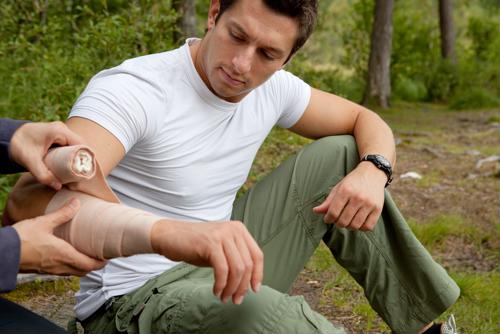All it takes is a simple cut or scratch to crack open your skin and leave the underlying layers of tissue vulnerable to the dangers of the outside world. Even for minor injuries, it’s important to know how to identify an open wound in order to avoid infections. It is important to always follow your physician’s instructions for care and treatment of open wounds.
Here’s your quick guide to open wounds:
 Understanding the different types of open wounds can help you heal faster.
Understanding the different types of open wounds can help you heal faster.Four types of open wounds
1. Abrasion
Most of us refer to abrasions as scrapes, which are open wounds caused by rubbing the skin against a hard or rough surface. Abrasions are shallow wounds that often don’t bleed.
Clean the wound by rinsing with water, and then flushing with a sterile solution to rid the affected area of bacteria and debris. Often times these open wounds will form a scab as a natural bandage. While tempting, avoid picking the scab as that can delay healing.
2. Avulsion
Avulsions occur when the skin tears away to reveal the tissue underneath. They usually happen as a result of violent car accidents or gunshots and lead to extensive bleeding.
Avulsions require immediate medical attention for proper treatment. While waiting for professional help, you can apply direct pressure to the wounded area in an attempt to stop the bleeding.
3. Laceration
Also known as cuts, lacerations are deep tears in the skin. Sharp objects, such as knives, are often the cause of this open wound. If the laceration is deep, bleeding is likely to occur.
Severe lacerations require immediate medical attention and may require stitches. You can treat minor lacerations by washing and disinfecting the wound, and then applying pressure and a sterile bandage. If there’s bruising or swelling, apply ice to the wounded area. It is important to remember that only a medical physician can dictate the severity of a laceration and it’s always best to seek medical help when you’re not sure of how to proceed.
4. Puncture
When a pointy, sharp object comes into contact with the skin, the result is often a small hole, known as a puncture wound. They don’t always bleed, which increases the risk of infection.
Seek medical assistance for proper treatment advice to avoid infection.
When to call your doctor
Healthline highlighted indicators that suggest an open wound needs a doctor’s attention, which includes wounds that are deeper than half an inch or bleeding that lasts for an extended period of time.
Your doctor can examine the wound and advise the appropriate treatment plan, which may involve regular dressing changes, pain medications or antibiotics.
Caring for your wound
iPAK by Innovative Outcomes can help you follow the doctor’s orders by packaging your wound care supplies with clear step-by-step video instructions. Delivered directly to your home, iPAK tells you what to apply to your wound and when.





